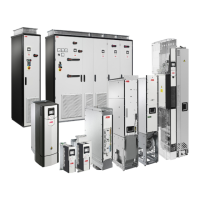Program features 83
Settings
Parameter groups 35 Motor thermal protection (page 293) and 91 Encoder module
settings (page 398); parameter 95.15 Special HW settings (page 414).
Motor overload protection
This section describes motor overload protection without using motor thermal
protection model, either with estimated or measured temperature. For protection with
the motor thermal protection model, see section Motor thermal protection (page 80).
Motor overload protection is required and specified by multiple standards including
the US National Electric Code (NEC), UL 508C and the common UL\IEC 61800-5-1
standard in conjunction with IEC 60947-4-1. The standards allow for motor overload
protection without external temperature sensors.
The Motor overload protection fulfills standard IEC/EN 61800-5-1 ed. 2.1
requirements for thermal memory retention and speed sensitivity. The estimated
temperature is retained over power down. Speed dependency is set by parameters.
The protection feature allows the user to specify the class of operation in the same
manner as the overload relays are specified in standards IEC 60947-4-1 and NEMA
ICS 2.
Motor overload protection requires that you specify a motor current tripping level. This
is defined by a curve using parameters 35.51, 35.52 and 35.53. The tripping level is
the motor current at which the overload protection will ultimately trip if the motor
current remains at this level continuously.
The motor overload class (class of operation), parameter 35.57 Motor overload class,
is given as the time required for the overload relay to trip when operating at 7.2 times
the tripping level in the case of IEC 60947-4-1 and 6 times the tripping level in the
case of NEMA ICS 2. The standards also specify the time to trip for current levels
between the tripping level and the 6 times tripping level. The drive satisfies the IEC
standard and NEMA standard trip times.
Using class 20 satisfies the UL 508C requirements.
The motor overload algorithm monitors the squared ratio (motor current / tripping
level)
2
and accumulates this over time. This is sometimes referred to as I
2
t
protection. The accumulated value is shown in parameter 35.05.
You can define with parameter 35.56 that when 35.05 reaches 88%, a motor overload
warning will be generated, and when it reaches 100%, the drive will trip on the motor
overload fault. The rate at which this internal value is increased depends on the
actual current, tripping level current and overload class selected.
Parameters 35.51, 35.52 and 35.53 serve a dual purpose. They determine the load
curve for temperature estimate as well as specify the overload tripping level.

